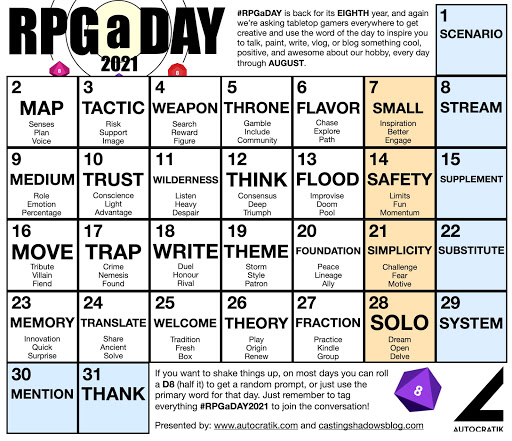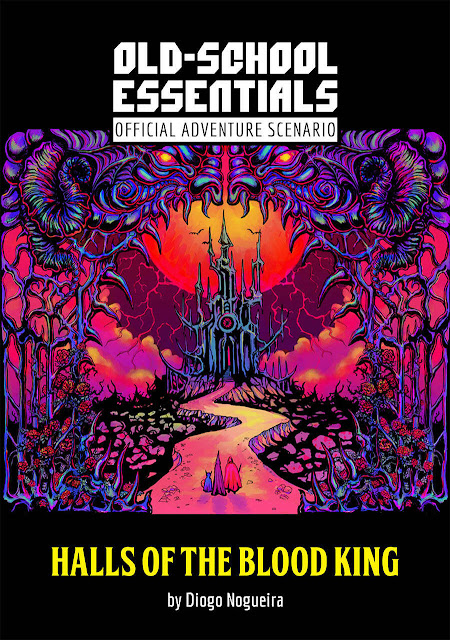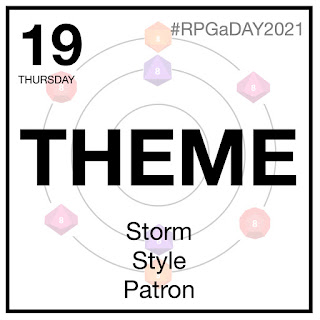
In the dim and distant past, an Abbot, a Cook, a Miller, a Smith, a Tanner, and a Tailor were wrongly incarcerated below Dark Castle for more years than any of them can recall. There came a moment for several of them to make their escape and take up their old lives again, but between them and freedom lay some fifteen encounters or locations, as well as a boss responsible for their imprisonment. Using their Cunning, their Might, and their Wisdom, they faced traps, monsters, choices, and more, all of which forced them to work together if they were to overcome these challenges and so make their escape. It was an all or nothing proposition—they all had to survive or none would and they all had to escape or none would!
This is the set-up for
Escape the Dark Castle: The Game of Atmospheric Adventure, a grim co-operative dice game published in 2017 which echoes the
Fighting Fantasy series of solo adventure books from the nineteen eighties. Published by
Themeborne,
Escape the Dark Castle is designed to be played by between one and four players, aged fourteen plus, so just like those
Fighting Fantasy books, it can be played solo. It can be played in thirty minutes or less—probably less because
Escape the Dark Castle is a brutally challenging game to beat and it offers plenty of replay value because of the number of cards it comes with and the random set-up each time it is played.
Centuries have now passed and Lieutenants Abbot, Cook, Miller, Smith, Tanner, and Tailor—perhaps the descendants of those who successfully escaped the Dark Castle?—have found themselves incarcerated in the detention block of a vast space station. Like their ancestors, they now have their own opportunity to escape their imprisonment, and just like back on Earth, the route they must take, between the detention block and their spaceship, is fraught with danger. The escapees must find their way out of the Detention Level, through the Heart of the Station, and then the Forgotten Zones to their impounded spaceship—and escape!
This is the set-up for
Escape the Dark Sector: The Game of Deep Space Adventure, the Science Fiction sequel to
Escape the Dark Castle. Designed to be played by between one and four players—so can be played solo—aged fourteen and up,
Escape the Dark Sector has a longer playing time than
Escape the Dark Castle. This is because
Escape the Dark Sector is moderately more complex than its forebear and adds new elements and rules to the format. However, this complexity adds new options for the players and flavour to both the story and play of the game which reflects the Science Fiction genre of
Escape the Dark Sector.
Funded via
Kickstarter,
Escape the Dark Sector comes as solidly appointed as
Escape the Dark Castle, if not more so. This includes six Crew Cards, forty-eight Chapter Cards, five Boss Cards, and three Start Cards, all of which are A6 in size. The twenty Item Cards, four Starting Weapons cards, six Starting Cybernetics, and two Tactical Action cards are all standard sized cards. The thirty-five, large six-sided dice are divided between the nine black Chapter Dice and the six white Crew Dice—just as in
Escape the Dark Castle, but also add four Hit Dice and sixteen Ammo Dice (representing a mixture of ballistic, energy, and explosive ammunition). A Medical Record pad—which actually looks like a heart rate tracker—and several pencils are included to track the Crewman’s Hit Points. The black and white rule book runs to some twenty-eight pages, over double the length of the rulebook for
Escape the Dark Castle.
The Character Cards depict Lieutenants Abbot, Cook, Miller, Smith, Tanner, and Tailor. Each has ratings in three Traits—Cunning, Might, and Wisdom. The ratings each Character has in these Traits indicates how many times they occur on their Character die. So, Lieutenant Abbot has four in Wisdom, three in Might, and one in Cunning, and the corresponding number of symbols appear on Lieutenant Abbot’s Character Die. Some of the symbols appear twice on the face a Character Die and in shield. When rolled, this means that a Character is twice as effective, whilst the shield indicates that all damage has been blocked. The Chapter Dice simply show the three symbols twice.
The Chapter Cards depict the creatures and challenges the crew members have to overcome and the horrors and choices they will face. Each Chapter Card clearly indicates what the Characters have to do, how many Chapter Dice need to be rolled if required, and how much damage the Characters will suffer if they fail. For example, the Characters might pass through the engineering deck where a neglected warp cell is in its final stages of destabilisation, pulsing intermittently and snaking out crackling tendrils of irradiated energy. They immediately lose a Hit Point due to the radiation, and have the choice of leaving the room immediately or searching for further equipment, but at the cost of further exposure to irradiation. Alternatively, the Characters find themselves locked in an alien laboratory containing a control terminal and a stasis tank in which floats a mutated humanoid monstrosity. One character has to work the controls, and if he successfully understands and manipulates the pattern of alien symbols, he can open the exit allowing everyone to escape. If not, the stasis tube powers down and the mutated humanoid monstrosity is freed… The Characters must defeat this creature before they can progress.
The Item Cards are a mix of consumables, equipment, and weapons. So, a bottle of Unmarked Pills can be consumed to restore a Hit Point or Brain Stim taken to change the result of a die roll to a Wisdom result; a Chrono-Bomb can be detonated to allow the reroll of all the dice; and the Beam Emitter ranged weapon comes with relatively high ammunition and rate of fire, but when fired has a chance of overheating and causing the Character wielding it to lose a Hit Point! One notable addition in terms of equipment is that of Cybernetic Implants. Every Character starts play with one of these, such as Advanced Targeting which lets the Character reroll an Ammo Die during ranged combat. This has the added effect of making the Character feel a little more different to each other—more so than in
Escape the Dark Castle. Each Character has enough space to carry four items, though some larger items count as double.
Lastly, the rulebook is a quick read and the rules are relatively easy to learn. Some close attention will need to be paid to the new rules, especially those for ranged combat and flanking.
Escape the Dark Sector requires some degree of set-up, more than its forebear. Not only does each player need to choose a Character, he also needs to select a Cybernetic Implant and one of the Starting Weapons. Ideally, this should be done together, so that the three Traits—Cunning, Might, and Wisdom—are best represented and enable the Characters to potentially deal with most challenges and enemies. All depending on luck and player choices, of course. Lastly, the Mission Deck is created. This consists of twelve Chapter cards, divided into three Acts of four cards each for the Detention Level, the Heart of the Station, and the Forgotten Zones, topped with a Start card and tailed with a Boss card. There are sixteen cards for each of the three acts, three Start cards, and five Boss cards, and the set-up is done randomly. This allows for plenty of variety in terms of challenges and replayability in the long term.
Game play begins with a player turning over the Start Card and reading it. Then the first Chapter Card is turned over and play proper begins. There is no turn order, the players deciding who will turn over each Chapter Card and what they will do to overcome them. It can be important who turns over a Chapter Card as some have conditions which apply only to the Character of that player. From one Chapter to the next, the Characters will find themselves fighting or evading a suddenly powered-up security ’mech; creeping past large glistening eggs which sprout acid-seeping tentacles; bribing or attacking their way past rival gangs; abducted, experimented upon, and found again; swarmed by alien insectoids, and more. Along the way they will find items which will help them and if they are lucky, they will be strong enough to face the Boss at the end of the dungeon and defeat him to escape.
The major addition to
Escape the Dark Sector in terms of rules is the ability for the Characters to engage in Ranged Combat. In some Chapters this is mandatory, others not, but adds new tactical options for the Characters, who can now Shoot and expect Return Fire from the enemy. To attack with a ranged weapon, a player rolls the Ammo Dice for that weapon—the number determined by the weapon’s rate of fire—and applies the effects. This varies from creature to creature, as some creatures are more susceptible to energy blasts than slug hits for example. It is also possible to miss and for weapons to suffer a malfunction which will harm the wielder. Instead of shooting, a Character can Flank the enemy, rushing out from behind cover to reach a better vantage point. This makes the Character vulnerable to attack from the enemy when moving, but it grants him a bonus attack in the extra Flank Round which takes place before the Ranged Combat or Close Combat Rounds. This bonus attack can either be a Ranged Combat or a Close Combat attack, inflicts extra damage if successful, and it cannot be blocked, but it can only be done once per Chapter.
In Close Combat, the players have a number of actions to choose from, the first of which is the Fight action. This covers attacking and defending, each player rolling his Character Dice in an attempt to match the symbols on the Chapter Card which represents the enemy. Unless a player has rolled a Shield on one of his Character Dice which would block any damage, his Character suffers damage automatically. Other actions include Reload—to reload any ranged weapon (so essentially when a Character finds a weapon, it comes with unlimited ammunition!), Trade or take an Item from another Character, Take Cover and take no action, and Activate Drone. The latter activates the drone carried in the backpack of one of the Characters. It heals the activating Character by one Hit Point and then recharges. It can only be used once per Chapter. This is a significant change to the game play of the format because in
Escape the Dark Sector, unlike in
Escape the Dark Castle, there is no Rest action during which a Character can heal. Between Chapters, the Characters are free to use Items or exchange with other Characters, and reload a weapon.
Escape the Dark Sector: The Game of Deep Space Adventure could simply have been a reiteration of
Escape the Dark Castle: The Game of Atmospheric Adventure, but with a Science Fiction. Fortunately, it is anything but that. Although very much based on the set-up and mechanics as
Escape the Dark Castle, the sequel is very much a development of it, adding theme and rules that are very much in keeping with both its Science Fiction genre and inspirations. Now the inspirations for
Escape the Dark Castle were in the fantasy and the
Fighting Fantasy solo adventure books of the eighties, but whilst
Escape the Dark Sector draws from the
Escape the Dark Sector solo adventure books for its style of play, its Science Fiction inspirations are the grungy, Blue Collar Science Fiction of the nineteen seventies and eighties, so
Alien,
Bladerunner,
Outland, and others. There is another inspiration too, but one from the nineties rather than the eighties, and that is the computer first person shooter, Doom. It is inspirational only though, and although
Escape the Dark Sector does involve gun combat, the resulting game is not a shoot ’em up. It is grimmer and more challenging, fraught with danger from one Chapter to the next.
Physically,
Escape the Dark Sector is well presented and packaged. The cards are all on a good linen stock and their artwork has a grubby, rough quality which fits both theme and setting. There is a certain pleasure to be had examining the artwork and spotting the references and so on. Lastly, the dice feel solid and heavy in the hands, just waiting to be rolled. The rulebook is decently presented and written, and includes rules for solo play as well as standard play with multiple players.
As much as the new rules and mechanics in
Escape the Dark Sector add structure and give the players options, they add complexity, they give more choices to be made, and thus they increase playing length. Whether coming to
Escape the Dark Sector or after having played
Escape the Dark Castle, the rules also need more attention paid to them because of their relatively greater complexity and increased procedural nature of play. However, a careful read through and a play or two of the game, and a gaming group should be fine.
Like its forebear,
Escape the Dark Sector: The Game of Deep Space Adventure is both fun and challenging to play, offering frustration in failing to escape the confines of the space station and elation in overcoming the challenges of the Chapter Cards and defeating the final Boss. The game is fairly quick to set up and play through, making it a good filler—though one which warrants occasional rather than regular play. The new rules and structured Mission Deck add options as well as better storytelling, all pushing the players to make more choices and work better together.
Escape the Dark Sector: The Game of Deep Space Adventure is an enjoyably brutal and challenging co-operative game, whether played solo or in a group.


















